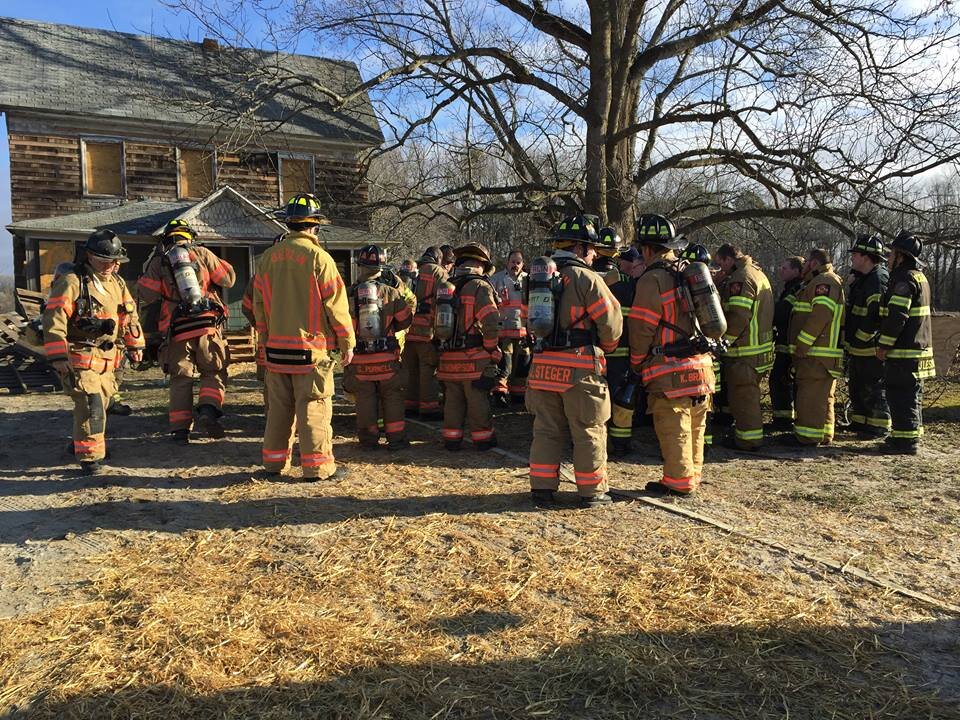Berlin, Ocean City, Showell, Girdletree and Ocean Pines firefighters participated

PHOTO COURTESY BERLIN FIRE COMPANY
Firefighters from several local companies battle a structure fire on Adkins Road in Berlin during a live burn training exercise hosted by the Berlin Fire Company on Feb. 17.
By Victor Fernandes, Staff Writer
(March 7, 2019) Firefighters at Berlin Fire Company don’t instantly leap into action after getting certain fire calls.
Although every second matters in real structure fires, live burn training exercises, such as what Berlin and several other Worcester County fire companies experienced Feb. 17 at a home on Adkins Road in Berlin, take meticulous preparation to assure potentially life-saving results.
On that day, nearly three dozen firefighters from Berlin, Ocean City, Ocean Pines, Showell and Girdletree companies performed a simulated search-and-rescue operation on the second floor of a home that was on the list of structures residents annually ask the Berlin Fire Company to burn down. They also conducted live fire training on the first floor during the roughly four-hour training session.
“It took 30 to 40 hours on that structure just to be able to do four hours of a burn,” Berlin Fire Chief James Corron, 39, said. “We generally will take a couple of weeks, if not almost a month, to prepare a house. There are specific things we have to do to the house to make it safe for us to do some sort of effective training. Certain safety considerations have to be made to do this preparation.”
Firefighters take every opportunity to learn how fire moves and how it behaves in as close to a real emergency setting as possible.
Unlike exercises conducted in concrete training centers, live burns conducted in traditional structures provide firefighters with greater insight into unique, often unpredictable, fires.
“We have to understand what fire does before we go put it out,” firefighter Nathan Thompson, 22, said. “It gives us a broad idea of what could happen at certain stages at which the fire grows, so that we know we can either go in and make a push or when we need to do different tactics. It just makes things go a lot smoother when the real thing happens.”
Still, companies need to take every precaution before having firefighters face a live burn, starting with inspecting the home’s structural integrity. If firefighters find safety hazards, such as holes in ceilings and floors, the company shifts to other training, such as working with young, less experienced firefighters on advancing and maneuvering hoses through and around structures before burning it down.
Once homes pass inspection, highly flammable materials like carpets are removed, Corron said, because “it lowers the flammability of that inside of the house.” Others handle other aspects of preparation such as boarding windows and creating escape routes.
Once the exercise begins, firefighters rely on basic skills they have learned over the years. On Adkins Road that day, veteran firefighters practiced effective ways to search rooms and handle hose lines inside, while cadets learned how to position ladders in front of windows outside, all under the watchful eye of Corron, Berlin Assistant Fire Chief Robert Rhode and other company leaders.
“We always try to build on the fundamentals of what we learned in our first days of Firefighter 1 class,” Corron said.
Materials needed to prepare for live burns cost money, ranging from $100 to $700, with the cost often covered by donations from within the community. But it’s the man hours volunteer firefighters put forth that are most valuable, because solid preparation in advance leads to a beneficial experience in and out of the burn zone. Firefighters are required to complete a class on preparing homes for live burns through the Maryland Fire and Rescue Institute at the University of Maryland in College Park.
“We’re looking to ensure people are being accounted for properly, making sure everybody is where they’re supposed to be,” Rhode, 41, said. “It’s a great opportunity to practice with live fire. When we have training evolutions like this with live fire in a house, it gets them prepared for new layouts of a house … how the fire may react and how it spreads to other rooms.”
Despite the long list of homes to burn, Berlin Fire Company secures fewer than 10 suitable homes per year for live burn training exercises. So their firefighters team with fire companies that also are well versed in live burns, either by hosting or being invited to participate in exercises.
“It takes a lot of time from the volunteers to be able to do this,” Corron said. “But it’s worth it to train our firefighters to be better.”
